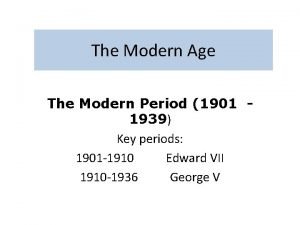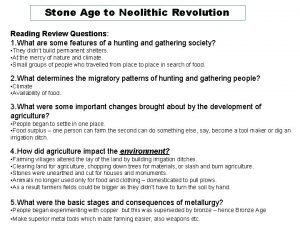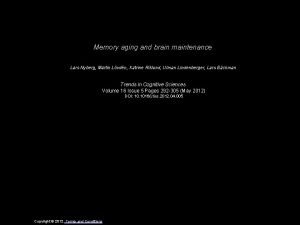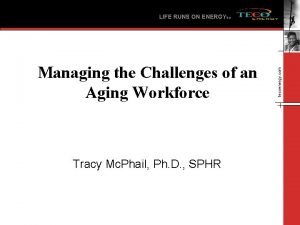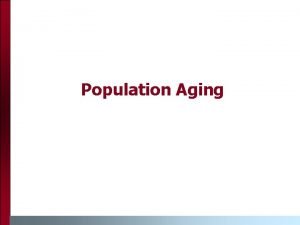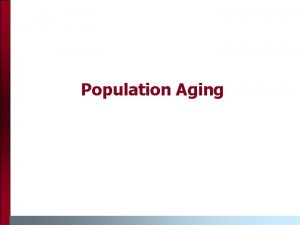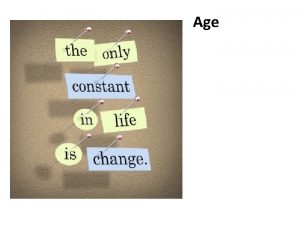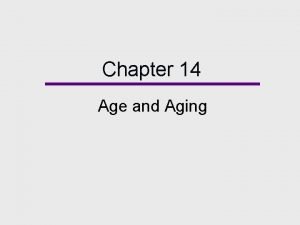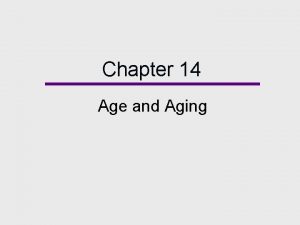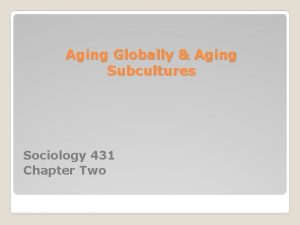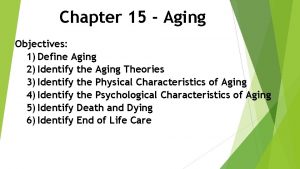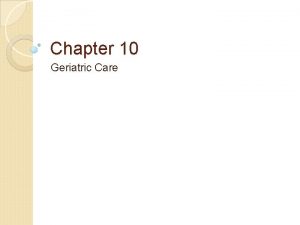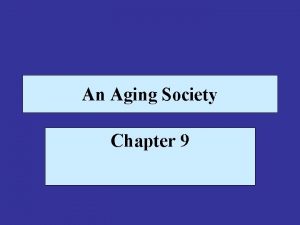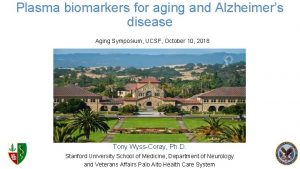Chapter 14 Age and Aging Chapter Outline l















- Slides: 15

Chapter 14 Age and Aging

Chapter Outline l l l The Social Significance of Aging A Society Grows Old Growing Up/Growing Old: Aging and the Life Course Death and Dying Age, Diversity, and Inequality Explaining Age Stratification

Social Significance of Aging l l l All societies practice age differentiation. Age stratification is the hierarchical ranking of different age groups in society. The age structure of the United States is rapidly changing, with a greater proportion of the population consisting of old people.

Physical Process of Aging l l l The effects of aging depend on biological, social, and environmental factors. Short-term memory becomes less accurate, but long-term memory becomes more accurate. Artistic abilities have been known to develop in later life.

Social Factors in the Aging Process: Menopausal Women l l l Stereotyped as unable to control their emotions and prone to irritability and depression. Evidence supports that menopause is not related to serious depression and that the majority of women are happy about the loss of ovulation ability. Studies also find that a majority of menopausal women do not experience hot flashes and other physical symptoms associated with menopause.

Life Expectancy l l l Probable number of years a particular group is likely to live, given statistical patterns. Based on the age at which half the people born in a particular year die. Shaped by social factors: gender, race, and social class.

Age Stereotypes l l Both the elderly and youth are burdened by negative stereotypes. Studies find adults perceive teenagers as irresponsible, lazy, sloppy, etc. Studies find the elderly are perceived as senile, meddlesome, conservative, inactive, unproductive, lonely, and uninterested in sex. Older women are perceived as having lost their sexual appeal, contrary to older men who are “dashing”.

Life Course Perspective Within each generation, life events shape the sociological experience of age groups: l Childhood l Youth and adolescence l Adulthood l Old age

Childhood The image of a childhood as carefree is not the reality for many children: l 1/4 of those living in shelters are children. l 26% of children live in poverty. l As many as 16% of girls under age 18 experience sexual abuse.

Youth and Adolescence l l l Until the 20 th century, children moved directly into adult roles, there was no adolescence. Establishing an identity is the central concern of this life stage. Special vocabularies and manners of speaking define independence from adults.

Adulthood l l Carries more responsibility, rights and privileges than any other stage in the life cycle. The economic and social resources one has influences how one experiences each phase of adulthood, including “mid-life. ”

Retirement l l l Maintaining social contacts from work and elsewhere eases the burdens of retirement. Taking on a job when retired creates social networks, which is linked to better health. Most pension systems discriminate against women who have on average lower lifetime earnings.

Old Age l l The majority of men and women remain sexually active well into their 70 s and 80 s. The majority of the elderly adjust well to changes. Only about 10% of the elderly become senile. One of the most difficult adjustments of old age is widowhood.

Theoretical Perspectives on Age Stratification l l Functionalism sees both youth and elderly as less useful or “functional” for society. Disengagement theory predicts that as people age, they withdraw from society and are relieved of responsibilities.

Theoretical Perspectives on Age Stratification l l Conflict theory sees ageism as eliminating youth and the elderly from competition over scarce resources. Symbolic interaction theory sees youth and the elderly as infantilized via cultural symbols, such as language and popular culture.
 Iron age dates
Iron age dates Iron age bronze age stone age timeline
Iron age bronze age stone age timeline Sandwich sentences
Sandwich sentences Victorian age and modern age
Victorian age and modern age Neolithic period timeline
Neolithic period timeline Romantic and victorian age
Romantic and victorian age Chapter 10:1 myths on aging
Chapter 10:1 myths on aging Beef steak market form
Beef steak market form Jessie emily schofield lyrics
Jessie emily schofield lyrics Drc uky
Drc uky Dane county aging and disability resource center
Dane county aging and disability resource center Trends in cognitive sciences
Trends in cognitive sciences Managing the aging workforce challenges and solutions
Managing the aging workforce challenges and solutions Office of aging and adults services
Office of aging and adults services Oaas
Oaas Puberty
Puberty



